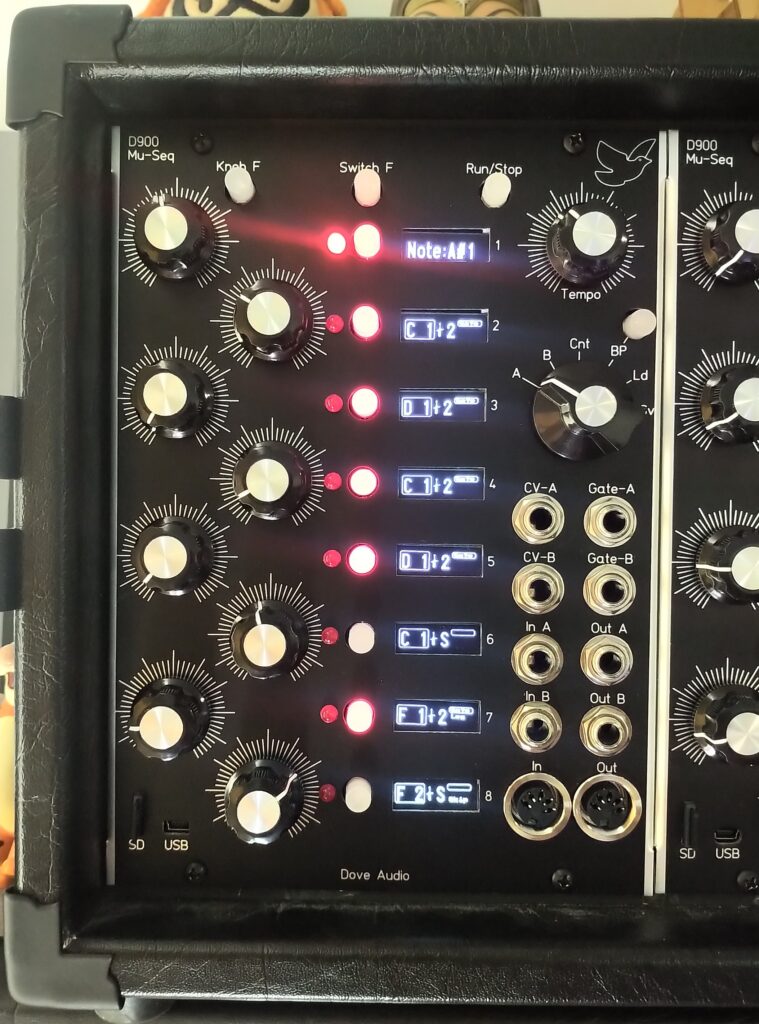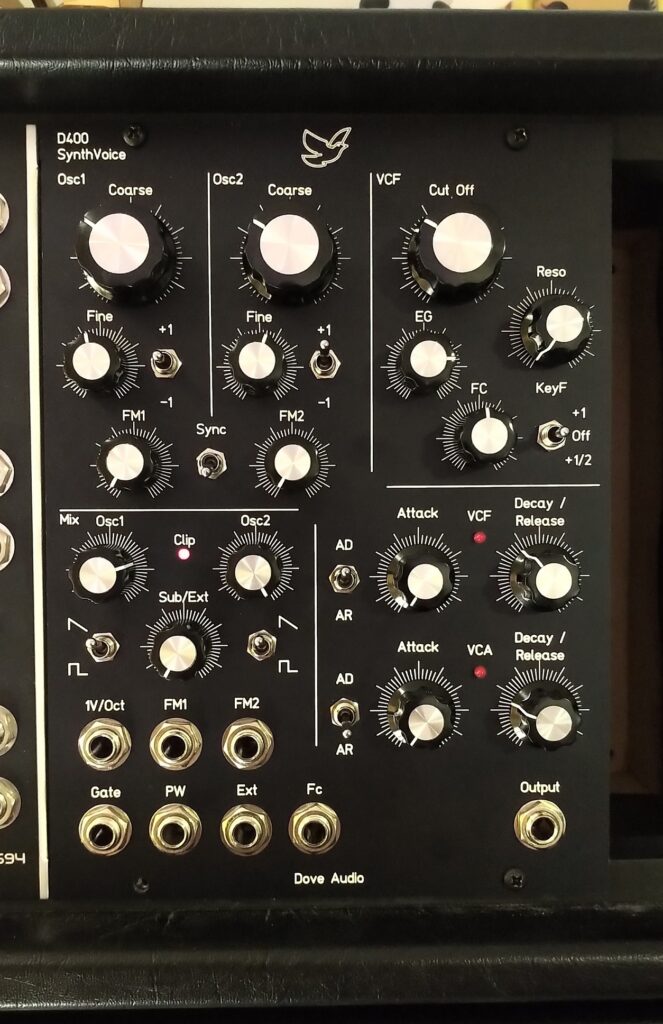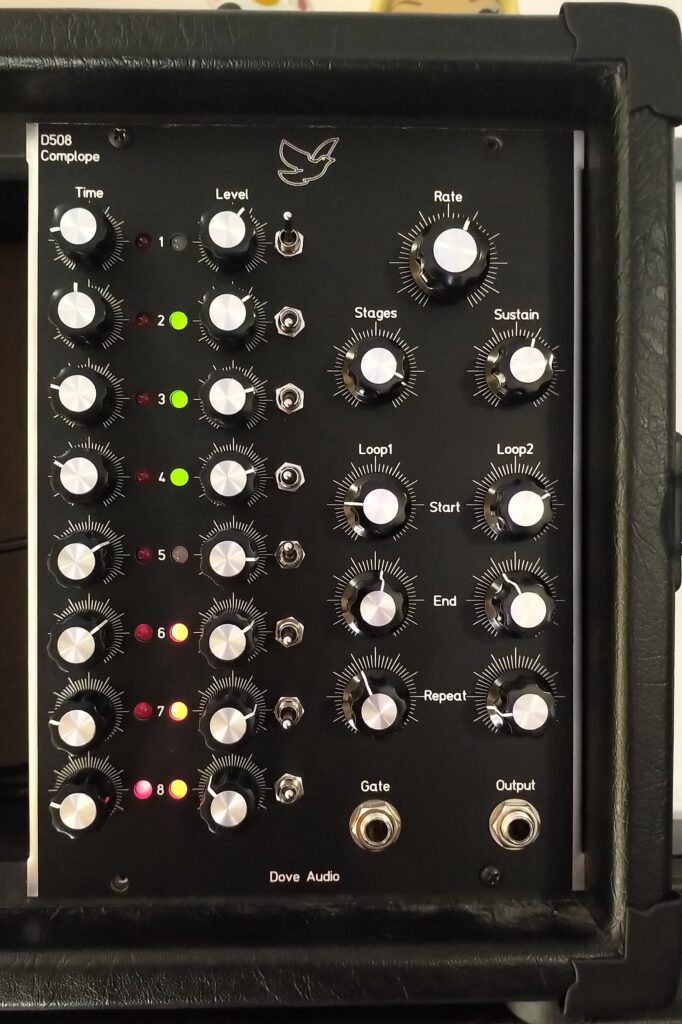Here we’ll be sharing what projects are in development and what stage they are at.
D900 MuSeq (95%)
MuSeq is a fully featured 8 step sequencer built on many years of experience with analogue sequencers and electronic music.

Features
The D900 MuSeq module is 3U wide and provides the following features;
- 8 Steps per pattern
- Two channels
- Channel A is Note CV and Gate, with per step;
- Selectable step length,
- selectable gate length (including double and triple gates i.e. ratcheting),
- Step on off,
- Legato mode (holds gate into next step),
- Skip mode
- Channel B can be switched from Note CV to variable CV with 512 steps and also has per step;
- selectable gate length (including double and triple gates i.e. ratcheting),
- Step on off,
- Legato mode (holds gate into next step),
- Skip mode
- Each pattern has different play modes, including;
- Forward
- Backward
- Forward + Backward
- Pendulum
- Random
- Brownian 55 (50% chance of going forward, 50% of going back)
- Brownian 52 (50% of going forward, 25% chance of going back, 25% chance of playing same note)
- Brownian 33 (33% chance of going forward, 33% chance of going back and 33% chance of playing same note)
- 2 CV inputs which can be used for;
- Tempo
- Pitch of channel A
- Pitch of channel B
- Run / Stop (0V = stop 5V = run)
- Clock In (0V = no clock, 5V rising edge causes a clock, continuous 8 clock per pattern required)
- Pattern Select (selects one of 8 patterns in a bank when pattern finished playing)
- 64 Patterns (8 banks of 8 patterns)
- Syncable from;
- MIDI clock
- Sync24 Din or rear STG clock connector
- Clock input above
- Provides constant sync outputs which is locked to the chosen input to the following outputs;
- MIDI sync out
- DIN Sync out
- STG Sync out
- Run/Stop + Clock Out (selectable from 1 clock per bar to 32)
- Bankplay mode, this allows you to chose which pattern play, for example you could have pattern 1 play, then pattern 4, then pattern 6. You can also chose the number of repeats from 1 to 16. For example pattern 2 could play 3 times, then pattern 7 once. This chosen arrangement will restart once completed. Patterns can be enable/disabled on the fly, as can their repeats.
- Patterns can be loaded, saved and edited whilst playing without affect speed or notes being played.
- Everything stored in plain text on a removable micro SD-Card
Status
As you can see there is a lot in this sequencer and currently there are two beta testers involved in finding bugs and advising on features to add, only 1 feature left to add and 2 bugs remain as of August 2022.
However, the chip shortages are likely to delay the release of MuSeq, but we are keeping a constant eye on parts and in touch with our assembly partners weekly.
D400 Synth Voice (60%)
The synth voice was designed for people who play a lot of live music and to provide a platform for a common sound, typically a bass or arpeggio. The idead being that the remainder of your modular is free for everything else exciting without tying up nearly 7 modules.

Features
The D400 is 3U wide and provides the following features;
- 2 x analogue VCOs with temperature compensation based on the SSI2131 chips and with the following available;
- Square and sawtooth outputs selectable
- Coarse and fine tune controls
- Octave up and down switch (3 way)
- FM input
- Additionally VCO2 can be hard sync’d to VCO1
- VCO1 also has a sub oscillator
- The mixer is 3 inputs, for Osc 1, Osc 2 and Sub oscillators as well as a clip LED
- The VCF is based on the incredible sounding SSI2144 chip and also temperature compensated and has the following
- Cutoff control
- Resonance control
- bi-polar EG depth
- bi-polar cutoff CV in depth
- There are also 2 simple envelopes with the following;
- Switchable from AD to ASR modes
- Attack Time
- Decay Time
- LED showing the shape
- At the end of this there is a VCA which is based on the SSI2162 chip and offers a fabulous signal to noise ratio.
- There are the following CV inputs;
- 1V/Oct
- Gate
- FM1 for Osc 1
- FM2 for Osc 2
- Pulse Width in (affects both Osc1 square and Osc 2 square)
- External Audio in (replaces the Sub oscillator when input is used)
- Filter Cut off CV
- A number of pre existing modulations are also available when no jacks are inserted
- VCF EG to FM2 (oscillator two pitch for those instant hard sync sounds)
- Osc2 output to FM1 (allowing FM synthesis)
- Osc1 output to Filter CV input (allowing FM of the filter)
Status
The first prototype is built and has some modifications on (that’s what prototypes are for after all). So modifications to the design need to be implemented and the PCB updated then ordered.
However the company that normally does my panels has recently moved and has had to stop working for 2 months.
D508 Complope (20%)
The D508 Complope is a complex envelope module. The idea for this came from my hunting for one of the encore UEG modules that lets you do complex shapes, the idea being that these could be used in conjunction with with WTF and Waveplane modules for complex movements though tables and morphs.

Features
The D508 has the following features;
- 8 Steps each with
- Time
- Level
- Selectable transition type (step, linear, exponential)
- Two loops (which can overlap) each with;
- Selectable start position
- Selectable end position
- Number of repeats 1 through 8 plus alternates
- Global Rate
- Selectable number of stages
- Selectable sustain step (1 through 8, loop1, loop2)
Status
This module is in it’s very early stages, a prototype PCB has been built and functions, however a lot of the code remains to be written.
Currently the 8 steps work with variable time and level, along with the two loops, however the only transition type available at the moment is step.
This module also uses a CPU, and that is currently unavailable, so we’re keeping our options open and we may change CPU at a later stage if alternatives become available.
